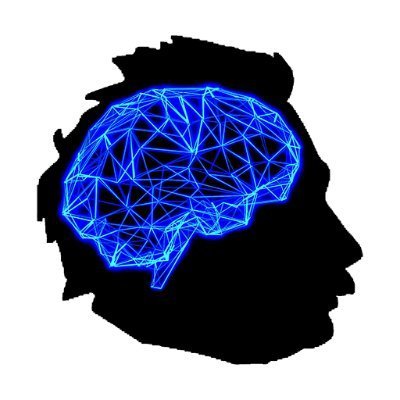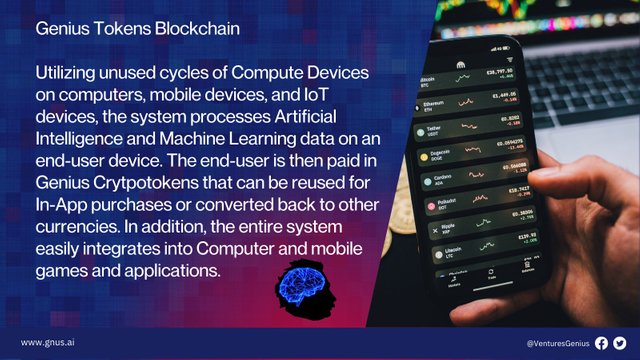Genius Tokens

Historically, access to high-performance computer systems was reserved for large companies that have
the technical, financial, and human resources to own and manage these systems. Over 5 billion
consumers interact with data every day, and Samsung estimates that this will be 6 billion by 2025.
Developers need better tools and methods to handle the additional processing required for high-volume
data processing, which has intensified the need for advanced computing and performance.
In response to this growing demand, companies such as Amazon Web Services (AWS), Microsoft
Azure and Google Cloud Platform (GCP) recently introduced cloud-based computing services for small
and medium-sized developers who need advanced IT resources to support a wide range of
applications. Although cloud computing resources can support global applications, the centralized
architecture introduces the issue of scalability.
Distributed computing solves the issue of scalability by spreading the demand of compute
processes across several high-powered machines.
The Genius tokens system infrastructure serves as a distributed multi-purpose service with a
cryptographic payment system that allocates computing resources and integrates them into real-world
projects. By purchasing Genius Tokens, developers buy as many scalable distributed resources as
necessary to power their projects. These tokens can be used in exchange for computing power, or they
can be exchanged for conventional currency.
By tokenizing computing power, developers can integrate their projects on blockchain technology and
leverage its inherent distributed architecture. Genius Token integration provides:
● A hybrid cryptocurrency and crypto token system allowing for high-speed transactions
decoupled from slower cryptocurrency architecture.
● Similar to cryptocurrency in-game purchases, payments and data resources are tied to the end-
user’s wallet.

● Transfer of data directly to the client or customer.
The growth of data processing and access requires improvements in infrastructure design. Although
changes can be gradual, they must support better performance as technology evolves in every industry
and more users expect high performance from any application regardless of its growth.
The International Data Corporation (IDC) predicts that the high-performance computing (HPC) sector
will experience a compound annual growth rate (CAGR) of 8%, which raised the total market to $31.4
billion in 2019. Rendering and visualization software grew at a CAGR of 30.03% from 2016 to 2020
with 3D visualization devices, virtual and augmented reality, and high-end video games fueling that
growth. Big data and business analysis revenue worldwide reached $150.8 billion in 2017, an increase
of 12.4% compared to 2016. The commercial purchase of BDA hardware, software and services
maintained a CAGR of 11.9% in 2020, when the turnover exceeded $210 billion dollars.
For example, the market for neural network software is expected to increase from $7.17 billion in 2016
to $ 22.55 billion by 2021. This is due to unclassified and recently digitized data since neural networks,
with intensive use of computers, are classifying machines.
Advanced risk analysis has a CAGR of 15.3%, which increases the market from $17.60 billion in 2017
to $35.92 billion in 2022. New technologies, such as artificial intelligence, allow institutions to improve
underwriting decisions and increase revenue while reducing risk costs. Computer and Block Desktop
grids can potentially interrupt all clouds, large data, and HPC economics. The IDC also forecasts
worldwide spending on cognitive and artificial intelligence systems will reach $57.6 Billion in 2021.
Currently, several solutions for high-speed processing of transactions via a blockchain crypto token are
available. Some of these solutions attempt to use different techniques to speed up the verification of
transactions, but these solutions fail to meet the needs of the industry since current systems take up to
minutes for transaction verification. Other solutions attempt to solve this issue by using direct acyclic
graph (DAG) blockchain crypto tokens, but still fall short as decentralized applications are not
integratBlockchains like Ethereum offer a new approach to the work of decentralized applications (DApps).
Ethereum allows developers to write smart contracts and code applications that run on a virtual
machine (VM). This represents a potential revolution in the design and implementation of services such
as investments, finance, corporate financing, internet, insurance, forecasting markets, gambling,
distributed data processing and more.
The difference between traditional applications running on a VM and blockchain applications is that
blockchain requires minimal computing resources. Blockchain applications only need a few kilobytes of
storage, a low-resource VM and a high-latency protocol.
Existing clouds cannot meet the DApp requirements of decentralized infrastructure. At the same time,
industry and scientific communities are increasing their demand for more computing power to deploy
large-scale applications and manage large amounts of data.
Applications that manage big data and use artificial intelligence, machine learning, and other resource
intensive applications need high performance computer power, but small innovative development
teams often lack the funds and experience to provision, support, and use them. Even though cloud
providers reduce costs compared to hosting on-premises resources, the cost to provision high-powered
resources is still high.
Currently, data centers spend extensive amounts of energy running servers and cooling systems. Not
only is it expensive, but it can also have a significant negative impact on the environment. We need a
new form of decentralized cloud that can use blockchain computing and reduce the cost of using the
infrastructur
Genius Venture supports the emerging class of blockchain-based distributed applications and enables
cost-effective, high-performance computing by building decentralized cloud infrastructure. The
infrastructure uses DAG-based blockchain crypto tokens integrated with decentralized applications.
Our system is unique when compared to other known systems and solutions in that it provides a full
system that integrates a slow blockchain crypto token with a fast DAG-based blockchain crypto token.
The software is unique when compared with other known solutions by providing a way for applications
and games to utilize unused cycles from computing devices. Developers generate crypto tokens by
processing data using artificial intelligence or machine learning on devices. Typically, other
cryptocurrencies and crypto tokens are earned by what is known as mining. Mining uses computing
devices to solve complex mathematical problems to verify a block on the blockchain. This mining does
not process real data and is only used competitively to identify who completes the mathematical
calculation first to determine who wins mining payments.
A blockchain-based decentralized cloud connected with a hybrid cryptocurrency and crypto token
payment system allows on-demand, secure, and low-cost access to the most competitive computing
infrastructures. DApps rely on Genius Ventures to automatically search, find, provision, use, and
release all computing resources necessary for applications and their data.
We envision a new ecosystem of companies offering storage, server farms, data providers, web
hosting, and SaaS applications, all conducting business with each other through Genius Ventures. The
distributed cloud can open new markets for aggressive use of existing computing infrastructures.
Core Value Proposition
At Genius Ventures, we aim to address the needs of all decentralized businesses outlined below.
- DApp providers can perform off-chain computations on demand.
- Application suppliers lower computing prices of their decentralized applications by employing a
safe, reliable, and robust infrastructure. - The customer can select artificial intelligence (AI) or machine learning (ML) algorithms through a
customer portal on the customer’s secure servers. - Stand-alone applications, embedded systems or games with the SDK integrated can process
instructions. - Server suppliers provide their servers, leverage underused computing resources, and increase
their return on investment on existing infrastructure. The hybrid crypto token system uses a fast
internal DAG-based blockchain that executes transactions in microseconds. - Code and SDK run on all devices, including Windows, OSX, iOS, Android, Linux, Windows
Mobile, Xbox, PlayStation, Nintendo and IoT. - User setup costs are almost zero and users get paid to process data. Both incentivize users to
use your game or Genius Token Blockchain
Utilizing unused cycles on servers and mobile and IoT devices, the system processes AI and ML data
on the target device. The end-user gets paid in Genius crypto tokens that can be reused for in-app

purchases or converted back to other currencies. The following workflow demonstrates the way Genius
Token blockchain executes: